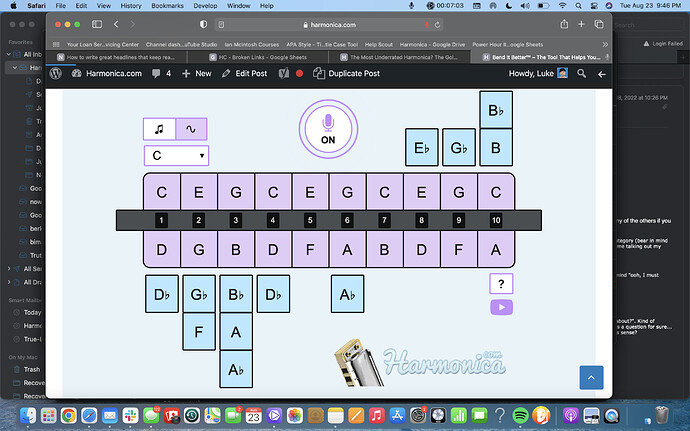Though I saw this post several days ago, I wanted to come back after reading the excellent essay you highlight above  on Jocelyn’s chromasthesia. I’d never heard of it, but after reading the article I can now better understand how it works. Her comments are very interesting, thanks so much to her for taking time to explain how colors and music effect those with Chromastesia.
on Jocelyn’s chromasthesia. I’d never heard of it, but after reading the article I can now better understand how it works. Her comments are very interesting, thanks so much to her for taking time to explain how colors and music effect those with Chromastesia.
As to the tuning on my Golden Melody, I did another test on an app I have on my phone called Bending Trainer (I like your Bending Tool for when I am on computer because I like how its set up visually, but use this one on my mobile device). The application allows to set different tunings and different Hertz, so I set it to Equal Temperament and 444 hertz.
The results were great!
I found a part of the application I hadn’t seen before which allows you to tell how many cents off you are on the tuning, and in which direction. On my Golden Melody in C, I’m within 10 to 20 cents across the board with easy blows and draws, and with a little effort, I can modify the aperture of my throat and hit the sweet spot with virtually all the notes.
I gotta tell you this was a lot of fun as I went through each of the notes and it reminds me @Luke of a post you made about LONG NOTES (holding the notes as long as possible and listening to all the subtleties in the tone of each).
It was exciting to see how I can increase the cents a bit by opening my throat on the notes that are just a bit flat, and restrict it a bit on those that are sharp to bring the tuning in line.
This whole experience has helped me to realize a couple of things:
First, and most important, I am glad to know my bad ass looking retro Golden Melody isn’t defective, it’s me that’s a bit off lol 
Secondly, it helps me to understand that while 10 or 20 cents of tuning many not seem like much, there is a difference!! I am amazed at how subtle movements in our mouth can cause the tuning to go up and down. Of course, this is the whole concept of bending, but now I can now see how subtle those differences can be.
I’ve always wondered about the relationship to whistling and the harmonica, and I believe I’m coming to understand at least part of it. When we whistle, we involuntarily change the shape of our lips, tongue and throat to come up with different tones. We don’t know what notes we are playing, or what key we are in. All we know is that when it sounds right it can be beautiful, and when it’s doesn’t, it can sound REALLY BAD.
Seems to me something similar happens with the harmonica. Most of what I play, comes from the way I hear it in my head. If you ask me what hole I’m playing, or if I am blowing or drawing, I really don’t know. I just know that when it comes together in the right sequence, it’s so COOL to be able to MAKE MUSIC.
Not everyone can sing or whistle, but for anyone who takes some time to play single notes, as our fearless leader @Luke is so apt at teaching, it’s amazing at what we can do with this simple instrument.
Thanks for helping me realize my Golden Melody isn’t a lemon, and is instead the bad ass lady that I know she can be!


 on Jocelyn’s chromasthesia. I’d never heard of it, but after reading the article I can now better understand how it works. Her comments are very interesting, thanks so much to her for taking time to explain how colors and music effect those with Chromastesia.
on Jocelyn’s chromasthesia. I’d never heard of it, but after reading the article I can now better understand how it works. Her comments are very interesting, thanks so much to her for taking time to explain how colors and music effect those with Chromastesia.



